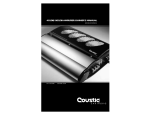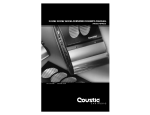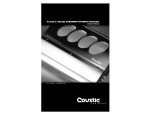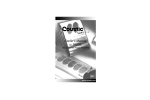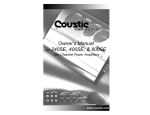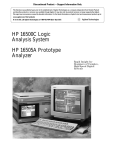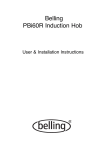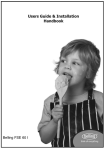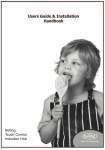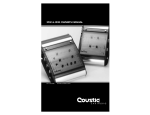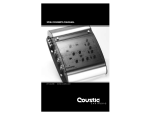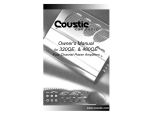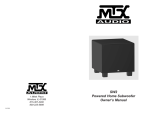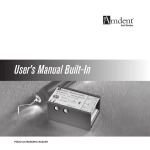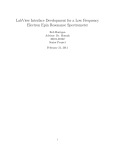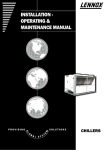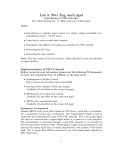Download Coustic 161SE Stereo Amplifier User Manual
Transcript
161SE AMPLIFIER OWNER’S MANUAL
877 COUSTIC
COUSTIC.COM
(MODE D’EMPLOI)
COUSTIC.COM
WELCOME
. . . to the Coustic world of power and clarity. The new 161SE amplifier delivers the cleanest
music you’ve ever heard at any power level in the 12-volt environment. Besides the sleek contoured design, the 161SE amplifier has all the latest and most sophisticated audio features. This
manual offers you a guided tour of all these exciting features. For the best sonic reproduction,
please follow the installation suggestions and recommendations as closely as possible. The time
you spend will prove to be worthwhile when you sit back and enjoy the high fidelity music!
To further explore the potential of your Coustic amplifier, we recommend you match it with our
dynamic full-range speakers or subwoofers and electronic crossovers.
Whatever you need for your ultimate car audio system, look to Coustic for a wide range of car
audio components to meet the most critical demands.
That’s because . . . COUSTIC ROCKS!
FEATURES
BUILT-IN ELECTRONIC CROSSOVER
An electronic crossover has many advantages over passive crossovers - lower cost, simplified yet
more flexible system design, lower distortion and higher gain structure. The 161SE power amplifier is equipped with built-in 18dB per octave electronic crossovers that can be configured for fullrange, high-pass or low-pass applications.
OVER-CURRENT, SHORT CIRCUIT AND DC OFFSET PROTECTION
The sophisticated circuitry monitors abnormal conditions such as voltage spikes, oscillation, DC
offset or short circuit. When any of these undesirable conditions exceed their respective preset limits, the circuit will shut down the audio system briefly and lights up the protection indicator to identify the problem for immediate attention. Once the problem is resolved, the amplifier will resume
operation automatically.
HIGH SPEED HIGH CURRENT MOSFET SWITCHING POWER SUPPLY
High current MOSFET transistors are used in the power supply section to minimize internal heat
and maximize reliability. Furthermore, the combination of the very high pulse-width-modulated
(PWM) switching frequency and the extra large filter capacitance guarantees stronger and deeper
transient bass response.
HIGH CURRENT/HIGH VOLTAGE FULLY COMPLEMENTARY OUTPUT STAGE
Complementary output stage audio circuitry has long been a hallmark of "exotic" home amplifier
design. Coustic is one of the very few car audio manufacturers to incorporate such elaborate
audio circuitry into its power amplifiers.
LINE OUTPUTS
The amplifiers full-range line outputs can be used to feed signals to another amplifier for your
future expansion or for setting up a more sophisticated system.
WIDE RANGE INPUT SENSITIVITY ADJUSTMENT
No part of this publication may be reproduced, stored in a retrieval system, or transmitted in any
form or by any means, electronically, mechanically, or otherwise, without the prior written permission of Coustic or Mitek Corporation.
Please take a moment to register your purchase on line at coustic.com.
Please also record the serial number of your amplifier in the space provided below and keep this
manual for future reference, as well as your sales receipt as proof of ownership. (The serial number of your amplifier is marked on the bottom of its metal chassis.)
The input sensitivity level of this amplifier can be easily varied from as low as 100 mV to as high
as 5.0 volts by adjusting the control on the Input Panel.
LINE LEVEL AND SPEAKER LEVEL INPUTS
The 161SE features pre-amp inputs for use with head units that have RCA or line level outputs.
This amplifier also features speaker level inputs allowing the amplifier to work with head units that
donot have RCA or line level outputs. The audio signal can be obtained by simply connecting the
amplifiers speaker level input wires to the head units speaker level outputs wires. If you are using
a floating or common ground car radio, this amplifier is the best fit for your system. It is compatible with floating or common ground car radio speaker outputs even without a floating ground
adapter.
MULTI-FUNCTION PROTECTION INDICATOR
Serial Number:
Date of Purchase:
When the red protect indicator lights up it signifies a high operating temperature is detected and
the amplifier is temporarily shut down to allow for a cooling period. As soon as the temperature
returns to a safe level, the amplifier will restart and resume normal operation.
This indicator also lights up when the amplifier detects either an over-current situation, shorted
speaker outputs or a DC offset at the outputs. Turn off the amplifier, double-check all inputs and
speaker connections to make sure there is no short or inappropriate inputs. If all connections are
in order, turn on the amplifier to resume operation.
3
COUSTIC.COM
CONTROLS, INDICATORS, AND TERMINALS
INPUT PANEL
OUTPUT PANEL
Figure 1: Input Panel Terminals and Controls
Figure 2: Output Panel Terminals and Indicators
1. FILTER MODE SELECT SWITCH (MODE)
"HPF": Slide switch to this position if the amplifier is used as a mid/tweeter amplifier.
"OFF": Slide switch to this position if the amplifier is used as a full-range amplifier.
"LPF": Slide switch to this position if the amplifier is used as a subwoofer amplifier.
2. HIGH-PASS/LOW-PASS FREQUENCY SELECTOR (FREQ)
Select high-pass/low-pass crossover frequency: 80 or 120Hz.
3. INPUT SENSITIVITY LEVEL CONTROL (SENS)
The input sensitivity level can be varied from 5.0 volts to 100 mV depending on the output voltage of the source unit (refer to sub-section titled INPUT SENSITIVITY ADJUSTMENT).
4. LINE LEVEL INPUT (RCA)
To be connected to RCA pre-amp outputs from a source unit (i.e., radio, tape deck or CD
player).
5. SPEAKER LEVEL INPUT (SPKR LEVEL)
To be connected to speaker outputs from a source unit (i.e., radio, tape deck or CD player)
when RCA outputs are not available.
6. LINE LEVEL OUTPUT
This output can be used to connect to another amplifier for system expansion.
Note: This line level output is full range.
7. POWER AND PROTECT INDICATOR (PWR/PRT)
Green light indicates that the amplifier is "ON".
Red light indicates either a high current, short circuit or DC offset is detected at the speaker
outputs. The amplifier will revert to normal operation once the problem is rectified.
The Red indicator also lights up at a high operating temperature. Under this condition, the
amplifier will automatically shut down. As soon as the temperature falls to a safe level, the
amplifier will automatically resume operation.
8. POWER INPUT TERMINAL (B+)
To be connected to the positive terminal of the vehicle’s battery or other constant +12 V
source.
9. GROUND INPUT TERMINAL (GND)
To be wired to the vehicle’s chassis for ground.
10. REMOTE TURN-ON INPUT TERMINAL (REM)
To be connected to the remote control wire or power antenna lead of the source unit for
remote ON/OFF.
11. FUSE RECEPTACLE
12. LEFT/RIGHT SPEAKER OUTPUT TERMINAL
For connection to the speaker system.
5
COUSTIC.COM
INSTALLATION
By purchasing the 161SE power amplifier, you are already one step closer to experiencing the
purest and most natural sound quality in the automobile environment. To take full advantage of the
potential of this amplifier, before installation, we strongly recommend that you acquaint yourself
with all its available features and then spend some time in designing a system most suitable for
you, consider the components you have now and those that you plan on adding or upgrading in
the future.
The 161SE power amplifier is designed for use with a 12-Volt negative ground system. Installing
this amplifier in a vehicle with a POSITIVE ground system will result in severe damage to the amplifier, other audio components and/or the vehicle’s electrical components. If your vehicle happens to
run on a positive ground system, please consult your Coustic dealer.
Caution: Please follow all the installation recommendations and instructions in this manual. Installing
and/or using the amplifier in methods other than those outlined herein may reduce the performance capability of the amplifier. Any such installation or usage renders the product
warranty void.
Warning: The battery ground should remain DISCONNECTED at all stages of installation.
LOCATION
Ventilation: The primary deciding factor of amplifier location is heat dissipation. Despite its highly
efficeint heat dissipation design, the amplifier can be crippled by inadequate ventilation. Prolonged
operation at high volumes, combined with inadequate ventilation, may cause the amplifier to overheat and trigger the automatic shut down circuit until the temperature returns to a safe level. To
ensure adequate ventilation, the ideal location for the amplifier is a spot away from any heat
source, with at least 2 inches of clearance above and around the unit.
Vibration: Constant vibration could eventually cause the amplifier to come off from mount, resulting
in stress on wire connections, which, in turn, results in "open" or "short" circuit. For this reason, a
location with minimum vibration and a flat surface for secure and firm mounting should be chosen
for the amplifier.
Moisture: The amplifier should never be exposed to moisture and water.
Taking all the above into consideration, the best mounting position for the amplifier would be the
floor of the trunk or behind the rear seat back.
Once the location of all the components has been determined, plan the best routes for all the necessary wiring, making sure that the wires are easily accessible without dismounting the various
components.
MOUNTING
1. Place the amplifier at the desired location and use it as a template to determine the exact position of the mounting holes.
2. Mark the mounting holes with a felt pen.
3. Put the amplifier aside.
4. If the mounting surface is carpeted, cut out small circles of the carpet and padding around the
four mounting holes to expose the metal underneath.
5. Use a center punch to ensure drilling the exact position for the screws. DO NOT BEGIN
DRILLING UNTIL YOU HAVE PUT THE AMPLIFIER ASIDE. USING THE AMPLIFIER AS A
DRILLING GUIDE MAY CAUSE IRREPARABLE DAMAGE TO THE AMPLIFIER.
6. Mount the amplifier with the screws provided.
Figure 3: Upright Mount on Horizontal Surface Figure 4: Parallel Mount on Vertical Surface
The amplifier may be mounted upright on a horizontal surface (see Figure 3) or parallel to a vertical surface (see Figure 4). However, the amplifier should never be mounted upside down (see
Figure 5) for the simple reason that the hot air generated by the amplifier would have to go
through the unit internally on its natural upward path (i.e. "feedback" into the unit) and would result
in increased internal temperature. This would speed up the thermal shut down of the amplifier.
Figure 5: Inverted Mount
(Not Recommended)
7
COUSTIC.COM
Figure 7. Typical multi-amplifier system
Figure 6. Typical System connection
BI-AMPLIFICATION
A bi-amplified system normally consists of an active crossover and two amplifiers. The active
crossover divides the audio frequency spectrum into two ranges: frequencies below the crossover
point are directed to the amplifier driving the subwoofer(s), while all frequencies above the
crossover point are directed to the amplifier driving the mid-range/tweeters.
9
COUSTIC.COM
INSTALLATION
FOR BRIDGED MONO MODE
continued
INPUT CONNECTIONS
Connect the RCA input jacks of the Amplifier to the output of the Source Unit (i.e. radio, cassette
player or CD player). If line level output is not available, connect the speaker wires from the
source unit to the Speaker Level input of the amplifier.
Note: For bridged mono mode, we recommend a total load of 4 or 8 ohms.
1. Connect the left positive ("+") speaker output of the amplifier to the positive input terminal of
the speaker.
2. Connect the right negative ("–") speaker output of the amplifier to the negative input terminal of
the speaker.
Figure 10: Bridged Single Woofer Connection
Figure 8: High/Low Impedance Inputs
CAUTION: ANY DEVIATION FROM THE ABOVE SPEAKER CONNECTION MAY CAUSE
SERIOUS DAMAGE TO THE AMPLIFIER AND/OR SPEAKERS. PLEASE DOUBLE CHECK THE
CONNECTION BEFORE TURNING THE SYSTEM ON.
Note: Connect the black ground wire to the source unit ground only if alternator noise is
present.
SPEAKER CONNECTIONS
Connect the Amplifier to the Speakers. Use heavy gauge speaker wires (e.g. 8 - 10 gauge
desirable) for these connections.
FOR STEREO MODE
Note: We recommend a total speaker load of 2, 4 or 8 ohms per channel
1. Connect the left negative ("–") speaker output of the amplifier to the negative terminal of the
left speaker.
2. Connect the left positive ("+") speaker output of the amplifier to the positive terminal of the left
speaker.
3. Connect the right negative ("–") speaker output of the amplifier to the negative terminal of the
right speaker.
4. Connect the right positive ("+") speaker output of the amplifier to the positive terminal of the
right speaker.
Figure 9: Stereo Connection
11
COUSTIC.COM
CONNECTING AMPLIFIER POWER WIRE TO THE BATTERY
Note: Power cables are as important as battery capacity. Use only high quality power cables of
gauge size AWG 8 or larger for installation. YOU CAN NEVER HAVE TOO BIG OF A
POWER/GROUND WIRE!
Run the power cable through the interior of the vehicle connecting one end to the amplifiers B+
terminal and connecting the other end to the positive post on the battery. Be sure not to run the
power cable together with the audio cables as it would invariably cause radiated engine noise in
your audio system. If possible, run audio cables on one side of your car and power cables on the
other. Never route these wires underneath the vehicle body.
It is also advisable to install a circuit breaker/fuse 18” from the battery. This would effectively
lower the risk of the power cable catching fire should a short circuit occur in the audio system. A
circuit breaker or fuse with 50% of the main batteries’ amp hour rating is recommended. Going
larger in circuit breaker or fuse value means that you have NO protection. DO NOT over fuse!
Fuses on the amplifier DO NOT protect the amplifier, they protect the car.
ADJUSTMENTS
CROSSOVER SELECTION
The amplifier has built-in high-pass/low-pass filters that can be defeated by sliding the switch to
the OFF position.
1. When the high-pass is selected, the amplifier will be devoted to mid/tweeters.
2. When the low-pass is selected, the amplifier will be used to drive woofers/subwoofers.
3. When the filter is switched off, the amplifier is used as a full range amplifier.
CROSSOVER FREQUENCY SELECTION
Both the high-pass and the low-pass section offer 2 crossover frequencies - 80 Hz and 120 Hz.
Choose the setting according to your speaker component specification or to your particular
preference.
CONNECTING AMPLIFIER GROUND WIRE TO THE VEHICLE CHASSIS
Find a good ground spot on the vehicles chassis and remove the paint to reveal bare metal at the
contact point. Attach the ground wire to that contact point and connect the other end of the
ground wire to the GND terminal of the amplifier.
TERMINALS, LUGS AND CONNECTORS
High current terminals, lugs and/or connectors are also required to ensure a safe and sure electrical connection and conduction.
CONNECT THE AMPLIFIER REMOTE CONTROL
Connect the remote REM terminal of the amplifier to the remote output terminal of the source unit
to establish amplifier remote on/off through the power on/off of the source unit. If the source unit
does not provide a remote output, connect to its power antenna lead or other switched 12-volt
source, e.g. ignition switch.
RECONNECT THE BATTERY GROUND TO THE VEHICLE CHASSIS
Double check all the previous installation steps, in particular, the wiring and component connection. If everything is in order, complete the installation by reconnecting the battery ground to the
vehicle chassis.
Figure 11: Crossover Frequency Selection
INPUT SENSITIVITY ADJUSTMENT
The Input Sensitivity Control is located on the Input Panel. The objective of input sensitivity adjustment is to match the output of the source unit with the input of the amplifier. The output voltage of
individual source units can vary. For example, some source units have an output of 200 mV,
others have 5 Volts or more. To cater to these variations, the 161SE amplifier has an adjustable
input sensitivity level that ranges from 100 mV to 5 volts.
Adjusting this control requires some experimenting. Basically you want all the gain at the beginning of the system, NOT at the end (amplifier). Turn your source unit volume UP and keep your
amplifier gains at the minimum possible settings. This will give you the best sound and
signal-to-noise ratio.
Besides better sonic reproduction, proper input sensitivity also helps to prolong the reliability span
of your amplifier by eliminating excessive internal temperature generated by incompatible source
unit output and amplifier input.
Note : Turning the input gain UP does NOT indicate MORE power. Just MORE noise. The input
gain control IS NOT a power control. REMEMBER that the input gain control has nothing to do
with the power output of the amplifier.
13
COUSTIC.COM
TROUBLE-SHOOTING SECTION
Figure 12: Input Sensitivity Control
1.
2.
3.
4.
5.
6.
Turn the Input Sensitivity Control all the way down (counter clockwise).
Set the volume control of the source unit to approximately 2⁄3 of its maximum output.
Turn the balance control of the source unit to its center position.
Leave the tone (bass/treble) controls at their usual position.
Play a CD or tape track with wide dynamic range
To locate the optimum input sensitivity setting, ask the person assisting you to turn the Input
Sensitivity Control clockwise until audio distortion starts to develop. Turn the sensitivity
control counter clockwise slightly to minimize the distortion.
7. If you constantly switch between CD/tape and radio, you will need further adjustment since
radio output level differs from that of CD or tape. In this case, you need to locate a balanced
sensitivity setting which is best for both the output level of radio and that of CD or tape.
SYMPTOM
1. No power
PROBABLE CAUSE
Check connections to the amplifier's Ground, B+ & Remote terminals. Check connection at "+" terminal of the battery. Check the
remote turn-on terminal. Ensure it receives power when the
source is turned on (or when the switch is turned on). Refer to the
Installation Section. Check the power line fuse: if fuse is blown,
replace it; if fuse continues to blow, check the power wire and
also the amplifier for a short. If the short is in the power wire, fix
it; if the short is in the amplifier itself, see your Coustic dealer.
Check the voltage at the amplifier, and the remote ON/OFF
lead. The voltage should measure between 11V-15V. If the measurement is beyond this range, have the source unit checked out
by an authorized dealer.
2. Power without sound with
red power/protection
indicator on
Turn the amplifier off, and Check all input & output signal cables
and connections. Check the speakers for short with a VOM
(volt meter) or by connecting them to another audio system. After
making sure everything is normal, turn the amplifier on again.
3. Power without sound with
red power indicator on
The continuous red light of the power indicator signals a high
internal operating temperature, which results in the amplifier
switching off temporarily; when the amplifier cools down to a
safe level, the amp will automatically restart.
4. No sound from one side
Check balance control.
Check speaker connections.
Check signal input connection.
5. Very low sound from
both radio & tape
Check your source unit's fader control.
Check the amplifier's Input Sensitivity Level.
6. Frequent automatic
amplifier shut down
This indicates that the amplifier is operating at a continually
undesirable high internal temperature. High operating temperature caused by inadequate ventilation: Refer to the sub-section
titled LOCATION for better amplifier location.
High operating temperature caused by an excessively low
impedance load, say below 2 ohms stereo or 4 ohms bridged:
Check for bad speakers and/or electronic crossover, proper passive crossover components; if all else fails, try rewiring the entire
system.
High operating temperature can be caused by an incorrect input
sensitivity level: refer to sub-section titled INPUT SENSITIVITY
ADJUSTMENTS for correct setting.
7. "Motorboating": The
amplifier power indicator
going off repeatedly when
the audio system is on
Check the amplifier's connection to the battery.
Check battery voltage. If low, recharge or replace
battery.
Check all ground connections.
8. Whining noise when
engine is running with
noise varying with the
accelerator (noise level
varies with source unit
volume control).
Reroute power cable from battery to source unit directly,
bypassing the battery terminal in the fuse box. Check power
connections to be sure they are clean. Check ground
connections to be sure the ground wire is in direct contact with
the bare metal surface of the chassis (with that spot scraped
clean of all paint, rust or grease).
15
COUSTIC.COM
SYMPTOM
9. Constant level whining
noise (most noise with
source unit volume at
minimum)
CAUTION:
10. Radiated noise: crackling
noise on FM which is not
present when playing tape
or CD (noise varying slightly
with accelerator but is
present at all times)
PROBABLE CAUSE
Check for a ground loop in the system. Turn the system off
and one by one change the ground connections (by
changing to a different contact point,scraping the level
constant irrespective of metal clean of all paint, rust or
grease). Turn the system on and check for whining noise
after each ground change.
Do not disconnect the Power Amplifier's ground when the
system is on. This could damage the amplifier.
Check for defective signal cables. Disconnect signal cables
at the amplifier and listen carefully for noise. If the noise disappears, run a test pair of signal cables. If there is no undesirable whining noise, reconnect to the amplifier with the
new pair of signal cables. Check battery ground connection
to the vehicle chassis to make sure it is tight and clean.
Check battery negative terminal connection to make sure it
is tight and clean.
Check if the noise is actually radiated noise: Tune a portable
radio to the same FM station. Move the portable radio close
to the vehicle engine. If crackling noise comes from the
portable radio, then the noise you have in your vehicle
audio system is radiated noise.Check with a VOM (volt
meter) to make sure the antenna is really grounded to the
vehicle chassis.
To ensure a true ground, break the plastic covering of the
antenna lead and solder a piece of heavy wire (minimum
14 gauge) to the braided shield. Ground the other end of
the wire at the same point as the radio ground.
Check spark plug wires. They should be suppression-type
wire and less than 2 years old. Otherwise, replace them
with good quality suppression cables.
Make sure engine block is grounded to the vehicle chassis
at a bare metal spot (scraped clean of paint, rust and
grease).
Make sure hood is also grounded. If not, use a ground strap
(which is available from any auto parts store) to ground the
hood to the vehicle chassis.
SPECIFICATIONS:
161SE Amplifier
Rated Power @ 14.4 V (0.1 % THD):
4 Ohm Stereo
2 x 40 Watts
Rated Power @ 14.4 V (0.1 % THD):
2 Ohm Stereo
2 x 80 Watts
Rated Power @ 14.4 V (0.2 % THD):
4 Ohm Mono
1 x 160 Watts
Frequency Response:
20 – 20,000 Hz ± 0.5 dB
Input Sensitivity:
0.1 – 5 V
S/N Ratio @ rated power:
100dB
High-Pass Filter Crossover Frequency:
80/120 Hz (18dB/Oct.)
Low-Pass Filter Crossover Frequency:
80/120 Hz (18dB/Oct.)
Dimensions:
11" W X 23⁄8" X 71⁄4" L
(280 X 60 X 185 mm)
Due to continual product improvement, all specifications subject to change without notice.
17
FRANÇAIS
BIENVENU
...Chez COUSTIC, un univers de puissance et de clarté. Le nouvel ampli 161SE délivre la puissance la plus parfaite de toute l’industrie du ”12 volts”. En plus d’un fantastique design, le 161SE
est construit avec les technologies les plus récentes et les plus sophistiqués. Dans ce manuel, vous
trouverez une visite guidée de toutes ces excitantes caractéristiques. Pour obtenir le meilleur résultat sonore, veuillez suivre les instructions de montage aussi bien que possible. Le temps que vous
lui consacrerez sera utile pour atteindre un système haute-fidélité.
Pour exploiter au maximum le potentiel de votre ampli, nous vous conseillons de le combiner avec
d’autres produits COUSTIC, comme nos haut-parleurs, nos subwoofers ou encore nos filtres actifs,
qui sont prévus pour parfaitement fonctionner ensemble.
Quel que soit le produit dont vous avez besoin pour votre installation ultime, pensez COUSTIC,
avec sa large gamme de composants à même de satisfaire vos demandes les plus exigeantes.
C’est pour cela que COUSTIC ROCKS !
FRANÇAIS
COUSTIC.COM
CARACTÉRISTIQUES
FILTRE ACTIF INCORPORÉ
Un filtre actif intègre beaucoup d’avantages comparé à un filtre passif : coût réduit, plus simple,
plus souple, générant moins de distorsion et procurant plus de gain.
Le 161SE intègre un filtre actif à 18dB/oct, qui peut être configuré en passe-haut, passe bas ou
large bande.
PROTECTION CONTRE LES SUR-CONSOMMATIONS, LES COURT-CIRCUITS ET LE
COURRANT CONTINU SUR LES ÉTAGES DE PUISSANCE
Le très sophistiqué circuit de protection gère les conditions anormales de fonctionnement comme
les pics de tension, les oscillations, l’apparition de courant continu sur les étages de puissance ou
encore les court-circuits. Lorsque l’une de ces mauvaises conditions de fonctionnement dépasse ses
limites, le circuit coupe l’ampli pendant un instant et l’indicateur de mise en protection s’allume,
permettant d’identifier rapidement le problème. Lorsqu’il est résolu, l’ampli se remet en fonction
automatiquement.
ALIMENTATION PWM À TRANSISTORS MOSFET HIGH SPEED
Le 161SE intègre une alimentation PWM à transistors MOSFET ultra rapides à très haute capacité
en courant. Ces transistors sont très efficaces, ils ne chauffent que très peu et garantissent un
niveau de fiabilité extrême. De plus, l’alimentation PWM et le très grand nombre de capacité
garantissent des basses fermes et profondes.
ÉTAGES DE SORTIE TRIPLE DARLINGTON HIGH CURRENT/HIGH VOLTAGE
Les étages de sortie du 160SE utilisent des transistors triple Darlington qui sont ultra rapides. Ces
circuits sont longtemps resté l’apanage des réalisations HIFI ésotériques. Ils ont une très forte
capacité en courant, ils assurent une dynamique incroyable. COUSTIC est l’une des rares sociétés
qui utilise ce type de circuit dans le car-audio.
Aucune partie de cette publication ne peut être reproduite, stockée ou transmise, sous quelque
forme possible (mécanique ou électronique), sans l’accord écrit de la société COUSTIC ou MITEK
Corporation.
SORTIES LIGNE RCA
Le 160SE est équipé de sorties RCA. Elles permettent de connecter un autre amplificateur avec
une sortie pré-amplifiée. Ce système est de bien meilleure qualité qu’une simple séparation avec
des ”Y”. Il est possible de chaîner plusieurs amplis dans le cas d’une extension.
ENTRÉES RCA COMPATIBLES 5 VOLTS
Veuillez aussi noter ci-dessous le numéro de série qui figure sous votre ampli. Conservez ce
manuel comme future référence et comme preuve d’achat.
Le niveau d’entrée est réglable de 0,1 volt à 5 volts, ce qui est très flexible. Une telle plage de
réglage permet d’adapter le 161SE à toutes les sources du marché.
ENTRÉES LIGNE ET ENTRÉES HAUT-NIVEAU
Le 161SE a des entrées RCA pour une utilisation avec une source équipée de sorties RCA.Il est
aussi équipé d’entrées haut-niveau lui permettant d’être utilisé dans le cas ou la source ne serait
pas équipée de sorties RCA. Le signal est alors obtenu en connectant les entrées haut-niveau de
l’ampli aux câbles haut-parleur provenant de la source. Si votre source utilise une masse commune ou une masse flottante sur les sorties, cet ampli est ce qu’il y a de mieux pour votre système. Il est compatible avec les deux standards, et ce, sans adaptateur.
Numéro de série :
Date d’achat :
INDICATEUR DE PROTECTION MULTI FONCTIONS
Lorsque l’indicateur s’allume au rouge, cela signifie que l’ampli est en protection thermique et
qu’il est coupé le temps qu’il refroidisse. Dès que la température est revenue à un niveau acceptable, l’ampli se remet en route automatiquement.
Cet indicateur s’allume aussi lorsque le circuit de protection détecte une sur-consommation, un
court-circuit sur les HP ou du courrant continu sur les étages de puissance. Dans ce cas, veuillez
éteindre l’ampli pour procéder aux vérifications de câblage et de montage. Si tout est en ordre,
vous pouvez rallumer votre ampli.
19
FRANÇAIS
FRANÇAIS
COUSTIC.COM
CONTRÕLES, INDICATEURS ET CONNECTEURS
PANNEAU DES ENTRÉES ET DES CONFIGURATIONS
PANNEAU DES SORTIES
Figure 1: Panneau des entrées et des réglages
Figure 2: Panneau des sorties et des indicateurs
1.
Sélecteur du filtre actif
Position ”HPF”: Filtre passe haut pour des haut-parleurs avant ou arrière
Position ”OFF”: Filtre déconnecté, l’ampli passe tout le signal sans filtrage
Position ”LPF”: Filtre passe bas, pour filtrer un subwoofer ou un caisson
2.
3.
4.
5.
6.
7.
Indicateur de mise en tension et de protection
Led verte : l’amplificateur est allumé
Led rouge : L’amplificateur est en protection. L’ampli repasse automatiquement
au vert lorsque le problème est résolu. En cas de protection thermique, il faut attendre
que l’amplificateur refroidisse pour qu’il redémarre.
Sélecteur de fréquence 80Hz ou 120Hz
C’est la fréquence à laquelle le filtre agit.
8.
Connecteur d’alimentation (B+)
Doit être connecté au +12 volts de la batterie du véhicule.
Contrôle du niveau de sensibilité
Réglable de 5 volts à 0,1 volt, il doit être réglé en fonction de la source.
9.
Connecteur de masse (GND)
Doit être connecté à la masse du véhicule.
Entrées RCA
Doivent être connectées aux sorties RCA de l’autoradio.
Entrées haut niveau
Dans le cas ou votre autoradio serait dépourvu de sorties RCA, connecter les câbles
haut-parleurs à ces entrées
Sorties RCA
Ces sorties peuvent être utilisées si vous montez un amplificateur
supplémentaire
10. Connecteur de commande ”remote”
Doit être connecté au câble de commande ou au câble de l’antenne électrique de la
source. Ce bornier commande l’allumage et l’extinction de l’amplificateur.
11. Support de fusible
12. Connecteurs haut-parleurs
Doivent être connectés aux haut-parleurs.
21
FRANÇAIS
FRANÇAIS
COUSTIC.COM
INSTALLATION
En achetant le 161SE, vous avez déjà fait un grand pas vers un son pur et naturel. Avant de passer à l’installation et pour bénéficier de tout le potentiel de votre ampli, nous vous recommandons
de lire attentivement ce manuel pour bien connaître toutes les fonctions disponibles. Nous vous
recommandons de prendre le temps d’élaborer un synoptique pour optimiser vos composants et
pour intégrer vos futurs achats.
Le 161SE nécessite une alimentation 12 volts avec masse négative. L’installation dans un véhicule à
masse positive entraînera la destruction de l’ampli, du circuit du véhicule concerné ou encore
d’autres composants électriques. Si vous avez le moindre doute à ce sujet, contactez votre revendeur COUSTIC.
Attention :Veuillez suivre les instructions et les recommandations de ce manuel. Une utilisation dans
d’autres conditions peut réduire les performances de votre ampli. De plus, toute utilisation différente
entraîne la perte de la garantie légale.
Attention : La masse de la batterie doit rester déconnectée durant toute l’installation.
EMPLACEMENT
Refroidissement : Le facteur le plus important dans le choix de l’emplacement est sa capacité de
refroidissement. Malgré des capacités de refroidissement importantes, l’ampli peut souffrir d’un
manque de ventilation. Une utilisation à haut volume, combinée avec un mauvais refroidissement
peut conduire à la mise en protection thermique. Il faut donc éviter de placer l’ampli trop près
d’une source de chaleur, avec environ 5cm de vide autour.
Figure 3 : Montage horizontal
Vibrations :
Des vibrations trop importantes peuvent détacher l‘ampli qui ne serait plus retenus que par les fils,
ce qui est dangereux. C’est pour cela qu’un montage sur une surface plane, permettant de solides
fixations, est recommandé.
Humidité : L’ampli ne doit jamais être exposé à l’humidité ou à l’eau.
En suivant ces recommandations, le meilleur emplacement pour votre ampli reste à plat, dans le
fond du coffre, derrière les sièges arrières.
MONTAGE
Mettre l’ampli en position pour repérer les trous de fixation
Tracer les trous de fixation avec un feutre fin
Enlever l’ampli
S’il y a de la moquette, couper de petits trous pour le passage des vis, pour bien voir le métal en
dessous.
Pointer les quatre trous pour obtenir un perçage précis. Ne pas percer tant que l’ampli est en
place. Utiliser l’ampli comme guide de perçage peut entraîner d’irréversibles dégradations.
Fixer l’ampli avec les vis fournies
Figure 4 : Montage vertical
L’ampli peut être monté à plat sur une surface horizontale (figure 3) ou à la verticale (figure 4). Il
ne doit jamais être monté à l’envers (figure 5) pour la simple et bonne raison que l’air chaud
généré par l’ampli devrait traverser ses propres composants pour refroidir. Ce qui le ferait chauffer
plus encore.
Figure 5 : Montage à l’envers
23
FRANÇAIS
FRANÇAIS
COUSTIC.COM
Figure 7 : Système multi amplifié
Figure 6 : Installation traditionnelle
BI AMPLIFICATION
Un système bi-amplifié est généralement constitué de deux amplis et d’un filtre actifs. Les basses
fréquences sont orientées vers l’ampli du subwoofer pendant que le reste du spectre va vers l’ampli des médiums et des tweeters.
25
FRANÇAIS
INSTALLATION
FRANÇAIS
COUSTIC.COM
MONTAGE PONTÉ (minimum 4Ω)
1. Brancher le connecteur ”+” du subwoofer à la borne ”L +”
2. Brancher le connecteur ”-” du subwoofer à la borne ”R -”
CONNEXION DU SIGNAL
Connectez l’entrée RCA (input) de l’ampli à la sortie RCA de votre source. Un câble vendu
séparément est nécessaire. Si votre source ne dispose pas de sortie RCA, utilisez les sorties hautparleurs pour alimenter l’amplificateur pas les entrées haut niveau.
Figure 10 : mode ponté sur un seul subwoofer de 4 ohms
Figure 8 : entrées RCA et entrées haut-niveau
ATTETION : Toute autre utilisation ou type de branchement peut entraîner la destruction de l’amplificateur et l’annulation de la garantie. Veuillez vérifier deux fois les branchements avant de mettre sous tension.
NOTE : lors de l’utilisation des entrées ”haut niveau”, il faut uniquement brancher le câble noir
(situé au centre du connecteur) à la masse du châssis de la source, si un bruit d’alternateur apparaît dans les hp.
CONNEXION DES CÂBLES HAUT-PARLEURS
Il faut connecter l’amplificateur aux haut-parleurs. Veuillez utiliser du câble de bonne qualité d’un
diamètre ne pouvant être inférieur à 1,5mm2.
MONTAGE STÉRÉO (minimum 2Ω, 4Ω et 8Ω possibles)
1.
2.
3.
4.
Brancher
Brancher
Brancher
Brancher
le
le
le
le
connecteur
connecteur
connecteur
connecteur
”-” du hp droit à la borne ”R -”
”+” du hp droit à la borne ”R +”
”-” du hp gauche à la borne ”L -”
”+” du hp gauche à la borne ”L +”
Figure 9 : mode stéréo.
27
FRANÇAIS
CÂBLAGE DE L’ALIMENTATION AMPLI/BATTERIE
Les câbles d’alimentation sont aussi importants que la capacité de la batterie elle-même. N’utilisez
que des câbles de bonne qualité d’une section minimum de 10 mm2. Il est impossible d’avoir un
câble d’alimentation et de masse trop gros.
Faites passer le câble d’alimentation dans la voiture. Connecter une extrémité à la borne « B+ »
de l’ampli et l’autre extrémité à la borne « + » de la batterie. Pensez à bien séparer les câbles
d’alimentation des câbles RCA, pour éviter le rayonnement cause de parasites. Si possible, faites
passer l’alimentation d’un côté de la voiture et les câbles RCA de l’autre. Ne jamais coller l’alimentation ou les RCA au faisceau de la voiture (encore une source de parasites). Ne jamais faire
passer les câbles par l’extérieur du véhicule.
Il est indispensable d’installer un porte fusible à moins de 50cm de la borne positive de la batterie. Il peut éviter au câble d’alimentation de prendre feu en cas de court-circuit. La valeur du
fusible dépend de la puissance de la batterie, elle est égale à 50% de la puissance de charge
horaire de celle-ci (pour une batterie de 80 ampères/heure il faut un fusible de 40A). L’utilisation
de fusible de plus forte valeur, revient à éliminer la fonction de protection du fusible. Ne jamais
surévaluer le fusible. Les fusibles présents sur l’ampli ne protègent pas l’ampli mais la voiture.
FRANÇAIS
COUSTIC.COM
RÉGLAGES
SÉLECTION DU TYPE DE FILTRAGE
Le 160SE est équipé d’un filtre actif passe haut ou passe bas réglable
1. En position ”High Pass” (passe haut), le filtre ne laisse passer que les fréquences hautes
destinées aux haut-parleurs avant ou arrière.
2. En position ”Low Pass” (passe bas), le filtre ne laisse passer que les fréquences basses
destinées aux subwoofers
3. En position ”OFF” (déconnecté), le filtre est déconnecté et il laisse donc passer toutes les
fréquences
SÉLECTION DE LA FRÉQUENCE DE COUPURE
Il est possible de choisir deux fréquences de coupure en passe haut ou en passe bas sur le filtre
actif : 80 ou 120Hz. Commencez les réglages à 80Hz
CONNEXION DE L’AMPLIFICATEUR À LA MASSE DU VÉHICULE
Utilisez une bonne masse directement au châssis. Poncer la peinture jusqu’au métal. Relier cette
masse au bornier « GND » de l’amplificateur.
BORNIERS ET CONNECTEURS
Veuillez utiliser des connecteurs et des borniers de qualité pour assurer toutes les liaisons électriques.
CÂBLE D’ALLUMAGE ET D’EXTINCTION DE L’AMPLI
Connecter la borne « rem » de l’amplificateur au câble « remote » de la source. Si ce câble n’est
pas disponible sur la source, vous pouvez utiliser le câble « antenne ».
RECONNECTER LE CÂBLE DE MASSE DU VÉHICULE
Après double vérification de tous les points cités ci-dessus, et si tout est en ordre, vous pouvez
reconnecter le câble de masse entre le châssis et la borne « - » de la batterie.
Figure 11 : Réglage de la fréquence de coupure du filtre actif
RÉGLAGE DE LA SENSIBILITÉ
Le potentiomètre de sensibilité d’entrée est situé sur le panneau de configuration de l’ampli. Il permet d’ajuster le niveau d’entrée de l’ampli avec le niveau de sortie de la source. Certaines
sources ont un niveau de sortie de 0,2 volts alors que d’autres dépassent 5 volts. Pour s’adapter,
le 161SE est équipé d’un niveau d’entrée réglable de 0,1 à 5 volts.
Ce réglage est le plus délicat. Il faut une certaine expérience pour parfaitement régler la sensibilité d’un amplificateur. Le meilleur réglage de gain est celui où le niveau est le plus bas. C’est à ce
niveau que le rapport signal sur bruit est le plus grand et donc la qualité sonore la meilleure.
Un bon réglage de gain entraîne une meilleure qualité sonore et une meilleure fiabilité en
réduisant la température interne de l’ampli.
NOTE : La puissance de cet ampli n’est pas fonction du réglage de gain. Mettre ce potentiomètre
à fond ne donne pas plus de puissance. Si le niveau est trop haut vous risquez de détruire les
haut-parleurs (qui dans ce cas ne sont pas garantis). S’il est trop bas, votre installation manquera
de pêche.
29
FRANÇAIS
FRANÇAIS
COUSTIC.COM
EN CAS DE DIFFICULTÉ
Figure 12 : Réglage de la sensibilité
1. Tournez le réglage à fond dans le sens contraire des aiguilles d’une montre (minimum)
2. Montez le volume de votre autoradio à 2⁄3 du volume maxi
3. Vérifiez que la balance et le fader soit bien au centre
4. Vérifiez que les réglages de grave et d’aigu sont à zéro
5. Prenez un CD ou une cassette qui ”tape fort”
Placez -vous dans le véhicule et demandez à quelqu’un de monter le niveau jusqu’à apparition de
la saturation. Diminuez le niveau d’environ une heure.
Si vous passez du CD à la cassette puis à la radio, il vous faudra un peu plus de réglage pour
être parfait. Votre ampli est réglé.
Un bon réglage de gain entraîne une meilleure qualité sonore et une meilleure fiabilité en
réduisant la température interne de l’ampli.
Symptôme
1. Ne s’allume pas
Cause probable
Vérifier les connexions à l’ampli alimentation masse et remote.
Vérifier la connexion à la borne + de la batterie. Vérifier que le remote
délivre bien du 12 volts lorsque la source est allumée. . Vérifier le
fusible. S’il est cassé, remplacez le. S’il saute encore, vérifier le câble
sur toute sa longueur et l’ampli contre les court-circuits. Si le court-circuit est sur l’alimentation, réparer la. S’il est dans l’ampli, retourner
chez votre revendeur COUSTIC. Vérifier la tension aux bornes de l’ampli. Il faut 11 à 15 volts entre la masse et le +, ainsi qu’entre la masse
et le remote. Si ce n’est pas le cas, retournez chez votre revendeur
COUSTIC.
2. Il s’allume sans
son, le led rouge de
protection est allumée
Couper l’ampli, vérifier toutes les connexions et tous les câbles de si
nal et d’alimentation. Vérifier que les HP ne soit pas en court-circuit
avec un voltmètre. Après avoir tout vérifié, vous pouvez rallumer.
3. L’ampli s’allume, il n’y a
Le led rouge continu indique que l’ampli est en protection thermique,
pas de son, le led est rouge ce qui explique qu’il soit coupé en attendant de refroidir. Lorsque l’ampli aura retrouvé une température de fonctionnement normale, il se rallumera automatiquement.
4.Pas d’un son d’un côté
Vérifier la balance, vérifier les câbles des haut-parleurs, vérifier vos
câbles RCA et leurs connexions.
5.Son particulièrement bas.
Vérifier le fader, vérifier le réglage de niveau sur l’ampli, vérifier la
position du filtre actif.
6.Coupures de son fréquentes
L’ampli fonctionne dans de mauvaises conditions de température. Cela
peut provenir d’une mauvaise ventilation, d’un mauvais emplacement
de l’ampli, d’un mauvais réglage de gain (trop haut) ou d’un montage
à l’impédance trop bases (par exemple moins de 2 ohms en stéréo ou
moins de 4 ohms ponté). Voir chapitre concerné.
7. L’indicateur de mise sous
Vérifier la connexion à la batterie ainsi que le passage du câble.
tension varie lorsque l’ampli Vérifier la tension de la batterie. Si elle est trop faible, recharger là où
fonctionne
remplacer la. Vérifier les câbles de masse.
8. Parasite alternateur variant
avec la vitesse de rotation
du moteur
Faire repasser la câble d’alimentation de l’ampli à un autre endroit.
Faire passer un câble d’alimentation direct de la batterie à la source.
Vérifier toutes les connexions, elles doivent être propres et pas oxydées.Vérifier la qualité des masses en s’assurant que les contacts sont
bien sur le métal.
31
FRANÇAIS
Symptôme
9. Bruit de fonctionnement à
bas niveau
ATTETION :
10.Parasites rayonnants
présent en radio mais pas
en CD ou cassette. Le
parasite varie légèrement
en fonction du régime
moteur et il est présent
tout le temps.
Cause probable
Il faut chercher les boucles de masses en changement chaque point
de masse l’un après l’autre.
il ne faut pas débrancher la masse lorsque l’ampli est en fonction
nement. Cela pourrait l’endommager.
Vérifier les câbles RCA qui pourraient être endommagés ou coincés
sous une vis ou un siège. Pour s’en assurer, il suffit d’utiliser un câble
RCA « en volant ». Vérifier la masse du véhicule, elle doit être propre
et non oxydée.
Vérifier que le parasite provient bien de la voiture avec une petite
radio FM que vous approcherez de la voiture sur la même station
que sur votre source. Si vous entendez les mêmes parasites dans votre
radio portable, les parasites sont générés par le composant dont vous
vous êtes rapproché. Vérifier l’antenne radio et sa connexion à la
masse. Vérifier le déparasitage du véhicule. S’il a plus de deux ans,
changer les composants.
Vérifier la mise à la masse du moteur. Vérifier la mise à la masse du
capot du véhicule. S’il n’y en a pas, mettez-en une.
FRANÇAIS
COUSTIC.COM
CARACTÉRISTIQUES TECHNIQUES
161SE
Puissance sous 14,4volts (0.1% THD)
4 ohms stéréo
2 x 40 Watts
Puissance sous 14,4volts (0.1% THD)
2 ohms stéréo
2 x 80 Watts
Puissance sous 14,4volts (0.2% THD)
4 ohms ponté
1 x 160 Watts
Réponse en fréquence
20 - 20000 Hz (± 0,5dB)
Sensibilité d’entrée
0,1 à 5 volts
Rapport signal / bruit @ puissance maxi
100dB
Filtre actif passe haut
80 ou 120 Hz à 18dB/oct
Filtre actif passe bas
80 ou 120 Hz à 18dB/oct
Dimensions
280 x 60 x 185 mm
En raison d’améliorations constantes, toutes ces caratéristiques sont susceptibles de changer sans
préavis.
33
COUSTIC.COM
NOTES:
COUSTIC LIMITED WARRANTY
IMPORTANT NOTICE TO CONSUMER:
Coustic offers the following warranty to the ORIGINAL PURCHASER of COUSTIC products, purchased from an authorized Coustic dealer, within the period stated herein:
Coustic warrants the 161SE, 241SE, 401SE, 601SE, 481QE, 321QE amplifiers against defects
in material and workmanship for a period of ONE (1) YEAR from date of original purchase. The
limited warranty is offered as an Over The Counter (OTC) exchange providing that the product
was purchased from an authorized Coustic dealer and is accompanied by valid sales receipt at
the time of exchange. Replacement units will be warranted for the remaining portion of the original warranty period.
IMPORTANT:
THIS WARRANTY DOES NOT COVER INSTALLATION OR DAMAGE RESULTING FROM ACCIDENT, MISUSE, ABUSE, IMPROPER WIRING, INCORRECT VOLTAGE, OPERATING UNIT
AGAINST INSTRUCTIONS IN OWNER’S MANUAL OR ANY PRODUCT WHICH HAS BEEN
OPENED, TAMPERED WITH OR SERIAL NUMBERS REMOVED.
This warranty does not cover labor costs for removal and/or installation of the unit for repair.
Under no circumstances shall Coustic be liable for any special, incidental or consequential damages or for any other expenses incurred by reason of use or implied including any implied warranty of merchantability or fitness for particular use or otherwise.
This warranty gives the CONSUMER specific legal rights and he may also have other rights which
vary from state to state. Some states do not follow the exclusion or limitation of incidental or consequential damages, hence the above exclusions and limitations may not apply.
For additional information, call us at 1-602-438-2020, or visit our website at coustic.com.
35
7676 SOUTH 46 STREET, SUITE 2020, PHOENIX, AZ 85042
TOLL FREE 877 COUSTIC TELEPHONE 602 438 2020 FACSIMILE 602 438 7313
coustic.com
© 2 0 0 2 . C O U S T I C I S A R E G I S T E R E D T R A D E M A R K O F M I T E K C O R P O R AT I O N . A L L R I G H T S R E S E R V E D .
COU000767 RevB 1/02
NDM193



















